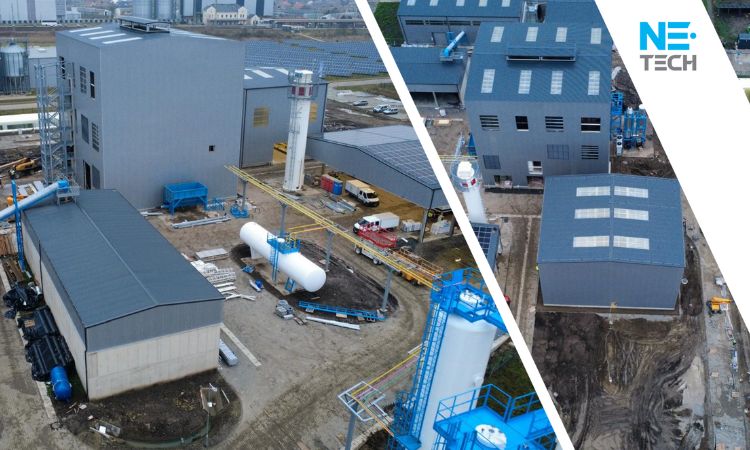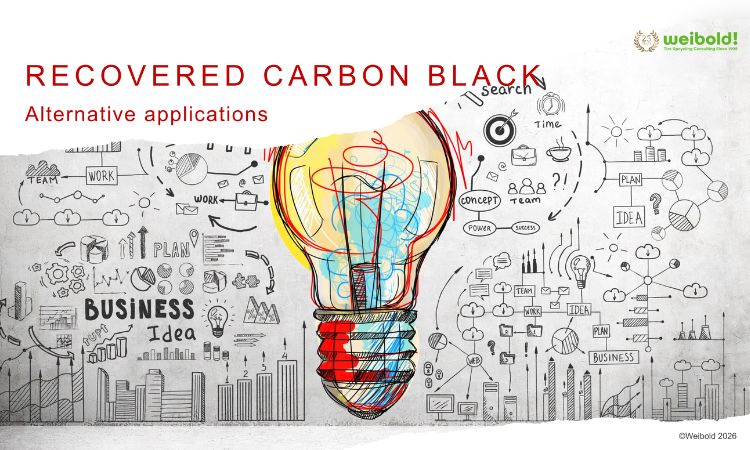Weibold Academy: the true circularity for end-of-life tires
Weibold Academy article series discusses periodically the practical developments and scientific research findings in the end-of-life tire (ELT) recycling and pyrolysis industry.
This article is a review by Claus Lamer – the senior pyrolysis consultant at Weibold. One of the goals of this review is to give entrepreneurs in this industry, project initiators, investors and the public, a better insight into a rapidly growing circular economy. At the same time, this article series should also be a stimulus for discussion.
For the sake of completeness, we would like to emphasize that these articles are no legal advice from Weibold or the author. For legally binding statements, please refer to the responsible authorities and / or specialist lawyers.
Introduction
Pyrolysis, an advanced chemical recycling route for End-of-Life Tires (ELT), is experiencing a boom in the last few years. As seen objectively, there is no one best design and/or process mode. Different options can be considered depending on the local circumstances and/or targeted product yields and qualities.
While only a small portion of global ELT arisings (31 million tons per year) are currently finding their way to thermochemical decomposition, recent developments are showing strong signs of promising opportunities. Global consumer sustainability awareness is driving policies from the United Nations (Sustainable Development Goals) on to state and local governments. Most of all, the industrial giants of all industry sectors are tightening their Corporate Sustainability Goals for a climate-neutral future. As a result, demand for high-grade tire-derived secondary raw materials (SRMs) as an alternative to their virgin counterparts is experiencing a phenomenal upswing.
Concurrently, large investments in research, development and refinement of the core technologies have resulted in breakthroughs of some candidates for rapid scaling to industrial-scale suppliers. Pyrolysis is the missing link in the truly circular tire rubber supply chain, as it can close the loop between the waste streams and the tire manufacturing process.
ELT Pyrolysis emerges as a game changer
Material recovery combined with chemical recycling/upcycling routes offers more value-added products and better environmental and resource efficiency compared to energy recovery practices. [Source] Chemical upcycling methods, particularly pyrolysis, have gained momentum for converting ELTs into high-value chemicals, materials, and fuels, contributing to the circular economy.
ELT pyrolysis is a molecular breakdown process conducted in an oxygen-free environment. Heat is supplied to the reactor (an endothermic process), leading to the thermal decomposition of the feedstock into pyrolysis products. It generates a liquid fraction (tire derived oil; TDO) with valuable chemicals and fuel properties, a raw recovered carbon black (rCB) containing all carbon blacks and inorganic compounds used in tire manufacturing, and a gas fraction rich in H2 and CH4 with a heating value similar to or higher than that of natural gas.
TDO and rCB serve as valuable substitutes for primary raw materials derived from fossil fuels, while the gas fraction provides the energy required for pyrolysis, making the core processes energy self-sufficient. This chemical upcycling of ELTs not only addresses waste management but also produces new raw materials from end-of-life tires, offering numerous environmental benefits.
Recent recognition of pyrolysis as a chemical recycling process by authorities like the U.S. Environmental Protection Agency (EPA) and the European Chemical Agency (ECHA) is expected to drive its development on a larger scale. Pyrolysis offers valuable secondary raw materials (SRMs) in the tire value chain, closing the loop between ELTs and tire manufacturing.
Pyrolysis, classified as an Environmental Sound Management (ESM) by the United Nations Environmental Programme since 2011 [Source], emerges as a game changer for ELT management and valorisation, supporting the transition to a circular economy model and the de-fossilization of the tire industry.
A Green Breakthrough in Circular Economy Strategies
The status of research and development activities on pyrolysis indicates its widespread adoption in Asian countries, while Europe, the USA, and Latin American countries are increasingly embracing it for transitioning to a circular economy. This acceptance is evident from the academic production and the growing number of research projects worldwide.
Overall, the research underlines that pyrolysis is the most strategic alternative for addressing the environmental concerns associated with ELTs compared to other common management practices like retreading, devulcanization, and materials and energy recovery. Furthermore, pyrolysis aligns with the principles of the circular economy, making it an important asset in the sustainable management of ELTs.
Apart from scientific publications, numerous projects are underway globally to advance pyrolysis as a sustainable solution for end-of-life tires (ELTs). One noteworthy example is the EU-funded BlackCycle Project, led by Michelin and Orion Engineered Carbons, aiming to establish an efficient value chain from ELTs to secondary raw materials (SRMs) through pyrolysis. These SRMs will be utilized to develop new tire ranges.
Another significant initiative in Europe, the ChemCycling Project, led by BASF chemistry, is dedicated to producing high-value chemicals (HVCs) from diverse waste streams, including plastics and ELTs.
All of these endeavors seek to decrease reliance on fossil resources and mitigate CO2 emissions, aligning with the ambitious targets set for 2050 in terms of sustainability and environmental impact reduction.
Tire derived pyrolysis oil a vital precursor for high-value chemicals
Tire derived pyrolysis oil (TDO), a complex mixture with diverse hydrocarbon species and molecular structures, is recognized as a highly promising product derived from the pyrolysis of end-of-life tires (ELTs). Over the past decade, its application as an energy source has been extensively studied. More recently, there is a rising interest in utilizing TDO as a precursor for chemical commodities. This growing interest has sparked various investigations focusing on TDO's production, characterization, upgrading, and its implementation in commercial systems, owing to its wide range of potential applications.
Tire derived pyrolysis oil (TDO) has traditionally been used as a petroleum-derived fuel in combustion applications due to its high energy density. Its compatibility with conventional crude oils and renewable characteristics makes it suitable as a precursor for drop-in-biofuels, meeting the growing energy demand without significant modifications to existing systems.
By integrating TDO as a co-feed stream in refineries, it can yield specific fuels like naphtha, light cycle oil (LCO), and liquefied petroleum gas (LPG), presenting significant potential in the hydrocarbons market. After refining, TDO can also serve as a feedstock for virgin carbon black (vCB), contributing to tire manufacturing and increasing circularity.
However, in line with circular economy principles, direct use of TDO as fuel shows limited circularity. Instead, TDO is gaining interest as a feedstock in various refinery units, enabling its transformation into chemical commodities. As such, TDO is considered a vital precursor for producing high-value chemicals (HVCs) like benzene, toluene, ethylbenzene, and xylenes (BTEX), essential building blocks in the petrochemical industry for various applications, including solvents, adhesives, plastics, and more.
Recovered Carbon Black (rCB) a sustainable substitute for fossil-based vCB
Recovered Carbon Black (rCB) is a new category of Carbon Black, as it is a heterogeneous nanomaterial comprised of a mixture of more than one grade of virgin CB with varying inorganic content (“ash”), particle size, morphology, surface chemistry and activity.
According to ASTM standard D8178 recovered Carbon Black (rCB) has typically semi-reinforcing properties in rubber after it was freed from residual metals and fibers and was properly milled.
Recent tests and research findings have shown that blending of rCB and vCB is possible without deteriorating the performance properties of rubber. Furthermore, during joint research conducted with its customers, the carbon black industry learned that 10-20% of rCB/CB blends can be used in most rubber applications following a particular industrial blending procedure. For specific applications, rCB content in the blend could be even increased to 30% or more. It is particularly noticeable that high quality rCB is up to 100% suitable as a replacement for virgin Carbon Black (vCB) in rubber and plastic products, in fiber threads, as well as in paints and inks.
The world market leaders Bridgestone and Michelin are emphasising in a much-noticed joint campaign the environmental benefits of replacing 10% of fossil vCB with rCB recovered from tires. This determination not only anticipates the general suitability of the rCB in tire products, but also the enormous demand of rCB.
Conclusion
The chemical upcycling of end-of-life tires (ELTs) through pyrolysis is a crucial part of the circular tire supply chain, serving as a waste management solution and a source of valuable high-value chemicals (HVCs). It helps in de-fossilizing various economic sectors. Recently, pyrolysis has been recognized as a chemical recycling process by authorities like the U.S. EPA and the European Chemical Agency (ECHA), which is expected to boost its development on a larger scale. Pyrolysis generates secondary raw materials (SRMs) for tire manufacturing, closing the loop between ELTs and tire production. Pyrolysis is believed to be a vital approach in achieving ambitious circularity goals in the coming decades. By integrating pyrolysis with conventional industries, the transition towards a more sustainable, circular economy and the de-fossilization of various industries can gain remarkable momentum.
Pyrolysis is a game-changing technology in the shift towards a circular economy and the de-fossilization of industries. It transforms end-of-life tires into valuable raw materials and fuels, addressing environmental concerns and promoting resource efficiency. Its increasing recognition by authorities and involvement of industrial giants in sustainable initiatives support its widespread adoption. By incorporating pyrolysis into tire management strategies, we can create a greener and more sustainable future, reducing our dependence on fossil resources and minimizing CO2 emissions in line with ambitious sustainability targets.
Literature:
Felipe Campuzano, Juan Daniel Martínez, Andrés F. Agudelo Santamaría, S. Mani Sarathy, and William L. Roberts; Pursuing the End-of-Life Tire Circularity: An Outlook toward the Production of Secondary Raw Materials from Tire Pyrolysis Oil; Energy & Fuels 2023 37 (13), 8836-8866; DOI: 10.1021/acs.energyfuels.3c00847
Weibold Academy: The superiority of chemical recycling via pyrolysis for end-of-life tires
Weibold Academy: ELT Pyrolysis - a Best Available Technology (BAT)
Weibold is an international consulting company specializing exclusively in end-of-life tire recycling and pyrolysis. Since 1999, we have helped companies grow and build profitable businesses.









